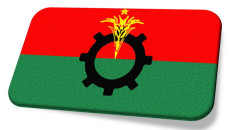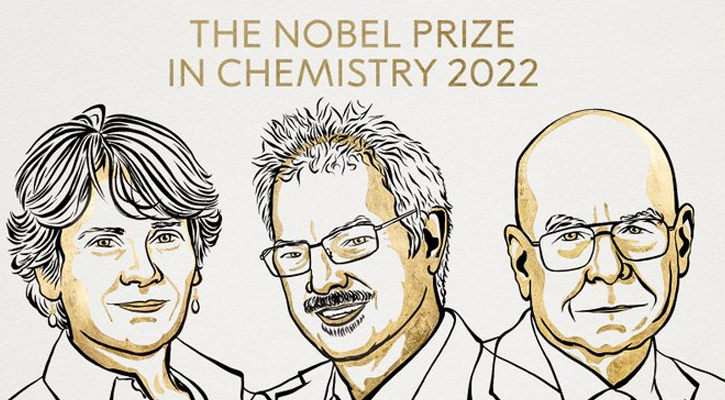
Rob Picheta and Katie Hunt, CNN
05 October, 2022 20:21
Three scientists win Nobel Prize for chemistry for ‘ingenious’ molecule-building tool

The Nobel Prize in chemistry was awarded Wednesday for work that led to “an ingenious tool for building molecules.”
Carolyn R. Bertozzi, Morten Meldal and K. Barry Sharpless became Nobel laureates for founding and advancing the fields of click chemistry and bioorthogonal chemistry, which has “led to a revolution in how chemists think about linking molecules together,” the Royal Swedish Academy of Sciences said.
Click chemistry enables fast and straightforward reactions, where “molecular building blocks snap together quickly,” the committee said. The principle can bring real-world benefits in the development of pharmaceuticals and medicine, including more targeted cancer treatments.
Sharpless and Meldal pioneered the concept before Bertozzi “took click chemistry to a new level,” the organizers said, by developing click reactions that work inside living organisms (or bioorthogonal reactions).
Click chemistry brings two molecules together “almost like a couple of pieces of Lego,” American Chemical Society President Angela Wilson told CNN on Wednesday.
“Bertozzi was responsible for doing click chemistry within the human body, which is absolutely remarkable,” Wilson said. “The three together have opened up new doors for us in what we can do, from pharmaceutical chemistry to materials chemistry,” and their work is already being used in manufacturing, she added.
Bertozzi told reporters at the winners’ press conference over the phone that her advancements are being used “to discover new kinds of molecules we didn’t know existed,” and means scientists are “doing chemistry inside human patients to make the drugs go to the right place.”
The Stanford University professor said she was told of her win in the middle of the night on the American west coast. “I can hardly breathe,” she said of her reaction. “I’m still not entirely positive it’s real.”
Double Nobel
Sharpless, a professor of chemistry at Scripps Research in La Jolla, California, meanwhile, became the fifth person ever to win two Nobels, joining a short list that includes pioneering chemists Marie Curie and Frederick Sanger.
Sharpless came up with the concept for click chemistry in 2001, the same year he won his first Nobel prize for chemistry. Working independently, Sharpless and Meldal, who is based at the University of Copenhagen in Denmark, came up with what the Nobel committee described as the “brilliant reaction” synonymous with click chemistry, which involves a catalyzed reaction between azides and alkynes.
“If chemists want to link two different molecules they can now, relatively easily, introduce an azide in one molecule and an alkyne in the other. They then snap the molecules together with the help of some copper ions,” the Nobel committee said in a document explaining why they had awarded the prize.
“It’s used to modify materials, for instance if you want them to conduct electricity or collect light or modify surfaces to become antibacterial,” explained Johan Elf, a member of The Royal Swedish Academy of Sciences and part of the committee that decided the honor.
Bertozzi developed click reactions that can be used inside living organisms – because they don’t involve copper ions which are toxic. She focused on glycans – complex carbohydrates that are built from various types of sugar and often sit on the surface of proteins and cells.
They play an important role in many biological processes, such as when viruses infect cells or when the immune system is activated, the Nobel committee explained.
Her bioorthogonal reactions – which occur without disturbing the normal chemistry of the cell – are used globally to map how cells function. Some researchers are now investigating how these reactions can be used to diagnose and treat cancer.
“Potentially, you can direct a radioactive marker to cancer cells and you can potentially deliver a toxic or radioactive compound to kill the cancer cell. It’s also used to direct enzymes to cancer cells that remove the carbohydrate layer so the cancer cell can be seen by the immune system,” Elf told CNN.
The Nobels are being awarded throughout the week; the prizes for medicine and physics were announced on Monday and Tuesday. Bertozzi is the only female scientist to have been awarded a science Nobel prize this year, after an all-male line-up in 2021.
The three winners will share prize money worth $915,000 (10 million Swedish krona).







 সিলেটে আ. লীগ নেতা খুন: ছেলেকে রিমান্ডে চায় পুলিশ, সন্দেহে আরও কয়েকজন
সিলেটে আ. লীগ নেতা খুন: ছেলেকে রিমান্ডে চায় পুলিশ, সন্দেহে আরও কয়েকজন 




 IT Lab Solutions Ltd.
IT Lab Solutions Ltd.
আপনার মন্তব্য